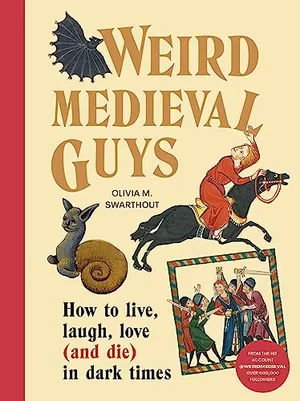Why Is Medieval Art So Weird?
Titled “Weird Medieval Guys,” a new book examines illustrations of armless frogs, human-sized snails and more
:focal(640x451:641x452)/https://tf-cmsv2-smithsonianmag-media.s3.amazonaws.com/filer_public/12/f3/12f3c029-a365-4fb3-a7f4-8c7891dda384/lion_playing_music.jpeg)
To today’s audiences, medieval art can look outright bizarre. Before the stylistic shifts that defined the Renaissance, medieval illustrations often featured flat, unrealistic figures and fantastical scenes.
But the details that make these drawings so baffling are also uniquely endearing. Now, author Olivia Swarthout hopes to capture the beauty of such oddball images in her new book, Weird Medieval Guys: How to Live, Laugh, Love (and Die) in Dark Times, which pulls from maps, artworks, manuscripts and more.
“A lot of it is about showing characters, people or creatures in medieval art that jump out of the page and have their own personality,” Swarthout tells Artnet’s Min Chen. “Humor is a really big part of it. I think it’s what makes people connect with it—they want to be in on the joke.”
Weird Medieval Guys: How to Live, Laugh, Love (and Die) in Dark Times
Explore what your medieval life would have been through a choose-your-own-adventure full of quizzes, how-to guides, diagrams and flow charts that takes you from your birth to your gruesome end, revealing your patron saint, the fate of your love life and the trials and tribulations you faced along the way.
Swarthout is a London-based data scientist. She became interested in medieval art thanks to an art history class she took while studying for her statistician’s degree. Four years ago, she started an account called Weird Medieval Guys on X, formerly known as Twitter.
Since then, she has been collecting the weirdest medieval images she can find, such as a woman throwing up a small demon, an eagle with human faces covering its body and a man with an indifferent expression being brutally stabbed in the head. She posts such images alongside understated captions like “turtle having fun, Germany, 15th century” or “a 14th-century door in Exeter cathedral that has a hole in it for cats to come and go.” Today, the account has over 600,000 followers.
“It’s been thrilling to see the interest in medieval art that my account has sparked,” she tells the Bookseller’ Lauren Brown. In the new book, “I think we’ve done a brilliant job of capturing the spirit of the original Weird Medieval Guys account while adding lots of brilliant new content for people to enjoy over and over again.”
Swarthout also has an Instagram account, a Substack newsletter and a podcast dedicated to medieval history. She hopes to debunk myths and misunderstandings surrounding the period. For instance, most of the artists drawing the “weird medieval guys” were “just people with a job to do,” she tells the Guardian’s Phil Harrison. “They weren’t imbuing their illustrations with a unique artistic spirit; they were just tradespeople.”
third wheel, france, 15th century pic.twitter.com/rmv0ZpUvXw
— weird medieval guys BOOK OUT NOW !! (@WeirdMedieval) November 10, 2023
Although the illustrations in the book are otherworldy, Swarthout manages to connect them to the present day, “noting the many parallels between medieval and modern life,” says Marianne Tatepo, publishing director of the imprint Square Peg, to the Bookseller. “From how hard wooing is, to landlord issues and the whole plague thing, we have much in common with our forebears.”
At the same time, Swarthout tries to avoid focusing too much on contemporary narratives or judgments about the images. Instead, she aims to provide new insights into everyday life during this period of history—which requires looking beyond criticisms of the art’s quality.
“People might ask why they couldn’t draw animals right or why certain things look weird, but I think that’s a reductive way of looking at it,” Swarthout tells the Guardian. “There’s so much contained in this art—and particularly in the fact that a lot of it isn’t all that well-executed or approached with the artistic precision that we’re familiar with—that actually tells us so much about medieval life.”
A Note to our Readers
Smithsonian magazine participates in affiliate link advertising programs. If you purchase an item through these links, we receive a commission.
/https://tf-cmsv2-smithsonianmag-media.s3.amazonaws.com/accounts/headshot/Julia_Binswanger.png)

/https://tf-cmsv2-smithsonianmag-media.s3.amazonaws.com/accounts/headshot/Julia_Binswanger.png)